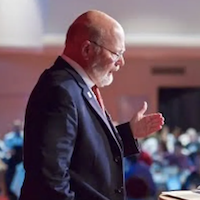How Blockchain Can Streamline Recordkeeping at Universities
What we see coming out of the pandemic is that the world is entering an environment for business and industry called the Fourth Industrial Revolution, which is a digitizing work. What that opens up for is that our delivery of documentation will change and will be delivered on the blockchain.
Ray Schroeder, Senior Fellow at the University Professional and Continuing Education Association, Professor Emeritus and Associate Vice Chancellor at the University of Illinois Springfield
The global shift of education to online learning as a result of efforts to stem the spread of the novel coronavirus pandemic has already served as the largest remote education experiment of its kind to date. Nearly 1.2 billion learners across the globe have been affected by school closures at the peak of the first wave of the pandemic in spring, according to the United Nations Educational, Scientific, and Cultural Organization (UNESCO).
The traditional four-year degree college education structure had already been challenged for some time, particularly by increased and decentralized alternative educational opportunities, often in the form of online learning. And this has become even more the case as job-hunters aim to learn new skills online and graduating high school seniors weigh the value of a degree from a traditional brick-and-mortar university campus compared to digital alternatives as the world enters the Autumn and Winter with a second wave of the pandemic building.
Given that the pandemic may have already accelerated the disruption of the traditional college business model, there is a critical need for students and employers to be able to verify and back educational background and expertise from various institutions and programs.
The initial technological darling of the financial and cryptocurrency world, blockchain, may provide the best contender to meet this need as it has shown promise in supporting educational claims and streamlining application processes. There is also the consideration of whether blockchain technology could, in turn, further accelerate a transition to alternative college business models as a result of the continued persistence of the pandemic as vaccine development and rollout remains in testing.
Meet the Expert: Ray Schroeder

Ray Schroeder is a senior fellow of the University Professional and Continuing Education Association (UPCEA) and professor emeritus and associate vice chancellor at the University of Illinois Springfield (UIS). He launched UIS’s online learning program in 1997, founded the university’s Center for Online Learning Research and Service, and became associate vice chancellor for online learning in 2013, a position he continues to hold.
Schroeder regularly publishes articles and book chapters, and presents nationally on emerging topics in online and technology-enhanced learning. He is the recipient of numerous national awards and citations for individual excellence and leadership from various associations and entities, including the Sloan Consortium, the U.S. Distance Learning Association, the American Journal of Distance Education, the Illinois Council for Continuing Higher Education, the University of Wisconsin and the University of Illinois.
What is Blockchain?
Blockchain emerged with the advent of bitcoin and other cryptocurrencies and is gaining momentum of interest from other industries such as logistics and supply chains, healthcare, and higher education. Before getting into blockchain’s applications and evolution in education, it’s important to understand what it is.
A simple entry in the online Merriam-Webster dictionary defines the technology as “a digital database containing information (such as records of financial transactions) that can be simultaneously used and shared within a large decentralized, publicly accessible network.”
But why call it “blockchain?” Because in its simplest form, the technology is literally just a chain of digital information “blocks” stored across computers in a public database or “chain.” This enables the technology to serve as a sort of public ledger.
Blocks on the blockchain comprise and store three main parts of information:
- Information about transactions or events (date, time, description)
- Who is participating in an event or transaction
- A cryptographic “hash code” generated by special algorithms that distinguishes a given block from other blocks
Each block can store an average of up to 1MB of data, and may, in practice, group together several events or transactions into a single block.
In order for a block to be added to the blockchain, an event or transaction must first occur. When this information is entered the data must then be verified by other public records of information, which is left up to a network of computers on which the blockchain exists. Once verified, the information will be stored in a block with a digital signature. It will then be given an identifying hash code, as well as the hash of the most recent block added to the blockchain, and finally be added to the blockchain.
The new block becomes publicly available for anyone to view, along with the related transaction or event data it holds. Anyone can view the contents of the blockchain, like that for Bitcoin, but users can also opt to connect their computers to the blockchain network as nodes. Each computer established as a node receives a copy of the blockchain that updates automatically.
This means there can be thousands to millions of identical copies of the blockchain. Spreading this information across a network of computers makes data more difficult to manipulate, and in the case of blockchain, there is no single account of events and would require a hacker to manipulate each existing copy on the network.
So, while transaction and event information on the blockchain is not completely anonymous, personal information about users is limited to a digital signature or username to protect privacy.
The Value of Blockchain for Higher Ed
For most of modern history, education and business information has been stored within a student or employee’s respective organization. But today’s economy has seen the increased movement of individuals between employment and education who need more autonomy and access to their data.
Enter the opportunity for blockchain.
Blockchain first entered the sphere of higher education in 2015 through a project initiated by MIT, says Professor Ray Schroeder.
Philipp Schmidt, the director of learning innovation at the MIT Media Lab had started issuing internal non-academic digital certificates to his team in 2015, according to MIT News. This prompted him to realize that despite the rise of decentralized, informal online learning opportunities there was no way to digitally track and manage these accomplishments. Faculty and staff at the university connected to discuss a concept to fill this need and worked to develop a pilot program granting students digital access to their diplomas.
“That was a huge change,” Schroeder comments. “When you got your transcripts from college you had to go to your registrar’s office and they were probably sending notarized papers. So in this traditional system, the university owns the transcript. You don’t own it.”
The big difference with blockchain dissemination of credentials is the student owns it, Schroeder explains.
“You of course can’t change what the university puts on related to your grades and classes—that’s written in stone and will be included in their documentation,” he notes. “But let’s say that you intern at a newspaper or a radio or television station someplace. You can write that in and link it to that employer for the internship. A person can add non-credit activities and experiences into their blockchain. Or maybe on the side, you took a coding course so that you could write Python language but it wasn’t from your university. But you can add that to your transcript document that is put on the blockchain.”
Blocks also allow for file attachments of things like a final project or syllabus for every course, which provides information that further describes a student’s work or mastery of a subject.
“For example, sometimes math courses are different at universities,” Schroeder states. “Being able to define what the learning outcomes for those courses are as part of the record that goes to the employer or prospective employer is very valuable.”
Human resource departments at big corporations like IBM and Amazon that get tens of thousands of applications each day can quickly scan blockchains and apply a value add to the internships. This allows HR to best assess students for things that may not have been seen or fully recognized on a paper review previously.
Blockchain records also mean that students can quickly access and send their data over to a prospective employer while avoiding educational bureaucracy or potential associated fees.
“Overall, it streamlines the whole process,” Schroeder says.
Covid-19 and Higher Ed Blockchain: Roadblocks and Anticipation
Although remote learning and alternative career certifications have been available for some time, the novel coronavirus pandemic’s combined effects of stay-at-home orders limiting in-person interactions and unemployment jumps have provided fertile ground for tech giants to roll out a slew of distance education offerings for people seeking to gain new skill sets.
While blockchain is poised to support the acceleration of decentralized and non-traditional college business models, the pandemic has exacerbated challenges to its widespread application and adoption by universities and businesses.
The technology had already faced some challenges according to a report on the use of blockchain in higher education published by the American Council on Education in June. The initial six-month study for the research initiative funded by the U.S. Department of Education found that despite large numbers of active blockchain experiments, many colleges and employers are still at proof of concept stages and face challenges in creating a common digital language and identity. The initiative is scheduled to run through September 30, 2021, so there may be time yet for results to improve.
The technology is promising should these issues be overcome, but for now, many brick-and-mortar universities are currently struggling with the shift to remote operations and must also still handle various urgent day-to-day crises arising in the mercurial pandemic environment.
“Universities are consumed with keeping their heads above water right now,” Schroeder describes the pandemic situation entering the new school year. “It is just taking everything we’ve got to get classes online and serve students from a distance and deal with outbreaks of a thousand students on some campuses. So that’s just totally distracting and it’s taking all the resources, so that’s slowing down the implementation and development [of blockchain] on campuses at the moment.”
There are some notable exemptions, like MIT and their advanced media lab, where things continue to progress, Schroeder commented. But what we see coming out of the pandemic is that the world is entering an environment for business and industry called the Fourth Industrial Revolution, which is a digitizing work.
“As companies have sent so many of their workers home [during the pandemic], many corporations have found it’s less expensive than maintaining any office space,” Schroeder says. “So businesses’ goal is to be able to serve those workers wherever they may be. What that opens up for is that our delivery of documentation will change and will be delivered on the blockchain. We’ll surely see more and more of that.”
Ultimately, the coronavirus pandemic situation is still fluid, but technology in education and other fields will remain under the spotlight more than ever through the end of 2020 into 2021.
So, despite current roadblocks to leveraging blockchain, further development can be expected of the technology. It could be a force to support a massive shift to alternative college business models in what is already becoming a drastically different market and economy.
